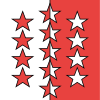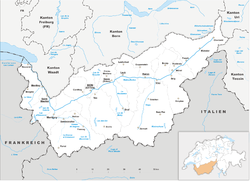
Back Kanton Valais Afrikaans Kanton Wallis ALS Cantón d'o Valais AN كانتون فاليه Arabic كانتون فاليز ARZ Valais AST وله (کانتون) AZB Kanton Valais BAN Вале (кантон) Byelorussian Вале BE-X-OLD
This article has multiple issues. Please help improve it or discuss these issues on the talk page. (Learn how and when to remove these messages)
|
Canton of Valais | |
|---|---|
| Canton du Valais (French) Kanton Wallis (German) | |
| Anthem: Notre Valais/Wallis, unser Heimatland ("Our Valais/Wallis, our homeland") | |
 | |
| Coordinates: 46°16′30″N 7°30′00″E / 46.275°N 7.500°E | |
| Capital | Sion |
| Subdivisions | 122 municipalities, 13 districts |
| Government | |
| • Executive | State Council (5) |
| • Legislative | Grand Council (130) |
| Area | |
• Total | 5,224.49 km2 (2,017.19 sq mi) |
| Population (December 2020)[2] | |
• Total | 348,503 |
| • Density | 67/km2 (170/sq mi) |
| GDP | |
| • Total | CHF 19.194 billion (2020) |
| • Per capita | CHF 55,313 (2020) |
| ISO 3166 code | CH-VS |
| Highest point | 4,634 m (15,203 ft): Monte Rosa |
| Lowest point | 372 m (1,220 ft): Lake Geneva |
| Joined | 1815 |
| Languages | French, German |
| Website | www |
Valais (UK: /ˈvæleɪ/ VAL-ay, US: /væˈleɪ/ val-AY; French: [valɛ] ⓘ),[a] more formally, the Canton of Valais,[b] is one of the 26 cantons forming the Swiss Confederation. It is composed of thirteen districts and its capital and largest city is Sion.
Valais is situated in the southwestern part of the country. It borders the cantons of Vaud and Bern to the north, the cantons of Uri and Ticino to the east, as well as Italy to the south and France to the west. It is one of the three large southern Alpine cantons, along with Ticino and the Grisons, which encompass a vast diversity of ecosystems. It is a bilingual canton, French and German being its two official languages. Traditionally, the canton is divided into Lower, Central, and Upper Valais, the latter region constituting the German-speaking minority.
Valais is essentially coextensive with the valley of the Rhône from its headwaters to Lake Geneva, separating the Pennine Alps from the Bernese Alps, the two largest mountain ranges of the canton. A major wine region, the canton is simultaneously one of the driest regions of Switzerland in its central Rhône valley and among the wettest, having large amounts of snow and rain upon the highest peaks found in Switzerland, such as Monte Rosa and the Finsteraarhorn. Although a major hydroelectricity producer, Valais is essentially renowned for its tourism industry and its numerous Alpine resort towns, notably Crans-Montana, Saas Fee, Verbier, and Zermatt. Overlooking the latter town, the Matterhorn has become an iconic landmark of the canton.
In 1529, Valais became an associate member of the Swiss Confederation. After having resisted the Protestant Reformation and remained faithful to the Roman Catholic Church, it became a republic under the guidance of the prince-bishop of Sion in 1628. In 1815, Valais finally entered the Swiss Confederation as a canton. In 1878, the Simplon Railway connected most of Valais with the cities of the Swiss Plateau. The canton was further opened up by the Lötschberg Railway in 1913.
- ^ Arealstatistik Land Cover - Kantone und Grossregionen nach 6 Hauptbereichen accessed 27 October 2017
- ^ "Ständige und nichtständige Wohnbevölkerung nach institutionellen Gliederungen, Geburtsort und Staatsangehörigkeit". bfs.admin.ch (in German). Swiss Federal Statistical Office - STAT-TAB. 31 December 2020. Retrieved 21 September 2021.
- ^ Statistik, Bundesamt für (21 January 2021). "Bruttoinlandsprodukt (BIP) nach Grossregion und Kanton - 2008-2018 | Tabelle". Bundesamt für Statistik (in German). Archived from the original on 1 July 2023. Retrieved 1 July 2023.
Cite error: There are <ref group=lower-alpha> tags or {{efn}} templates on this page, but the references will not show without a {{reflist|group=lower-alpha}} template or {{notelist}} template (see the help page).



